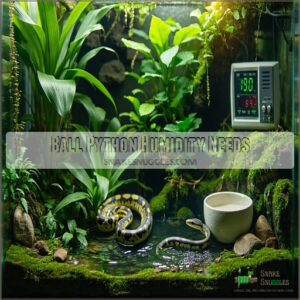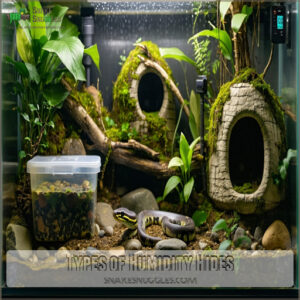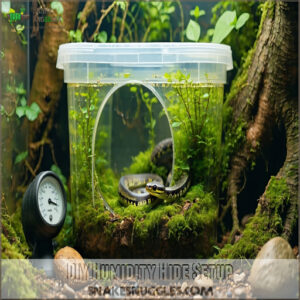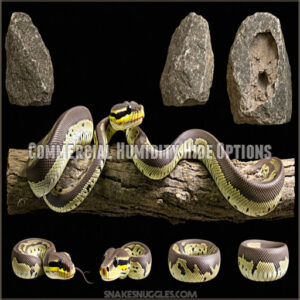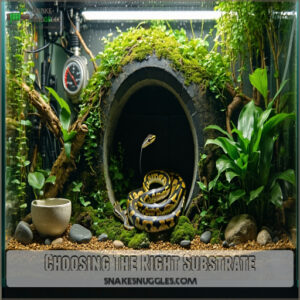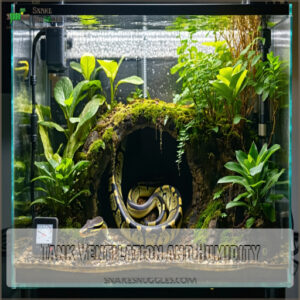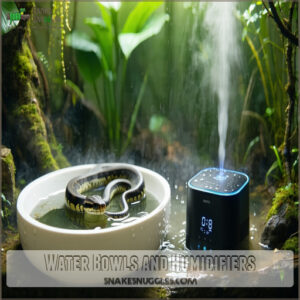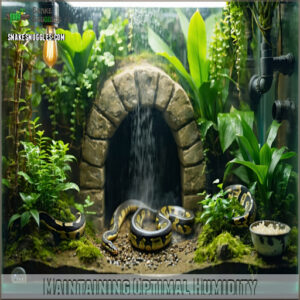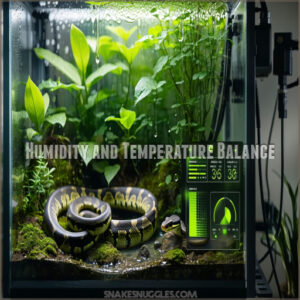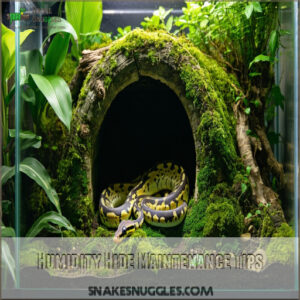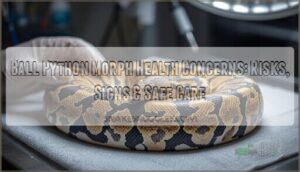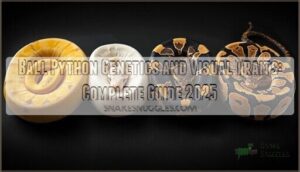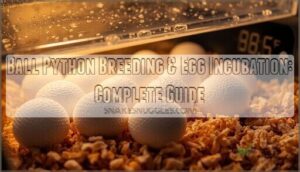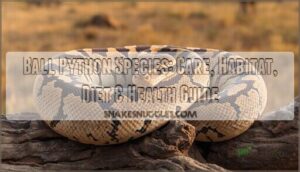This site is supported by our readers. We may earn a commission, at no cost to you, if you purchase through links.
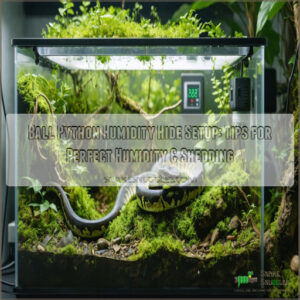 A proper ball python humidity hide setup keeps your snake cozy and healthy, especially during shedding.
A proper ball python humidity hide setup keeps your snake cozy and healthy, especially during shedding.
Start with a plastic container or commercial hide, lined with damp sphagnum moss or coconut husk to lock in moisture.
Aim for 70% humidity inside the hide, slightly above the tank’s ideal 50-60%.
A digital hygrometer is a must for monitoring.
Too dry? You’ll risk stuck sheds; too humid? Mold and bacteria could move in.
Place the hide on the warm side of the tank for best results.
Think of it as a spa retreat for your python—clean it regularly to keep things fresh!
Table Of Contents
- Key Takeaways
- Ball Python Humidity Needs
- Creating Humidity Hides
- Tank Setup for Humidity
- Maintaining Optimal Humidity
- Humidity and Temperature Balance
- Humidity Hide Maintenance Tips
- Frequently Asked Questions (FAQs)
- Do ball pythons need a humidity box?
- What is a humid hide for a ball python?
- How do you regulate humidity in a ball python enclosure?
- How to keep a ball python from shedding?
- What temperature should a ball python hide be?
- Does misting a ball python increase humidity?
- How to make a humid hide for ball python?
- Is 70% humidity too high for ball python?
- How to build a humid hide?
- How to keep humidity up in a ball python enclosure?
- Conclusion
Key Takeaways
- Set up a humidity hide using a plastic container lined with damp sphagnum moss or coco coir, and place it on the warm side of the tank to maintain 70% humidity for shedding.
- Use a digital hygrometer to monitor the moisture inside the hide and ensure it’s consistently at the right level.
- Clean the humidity hide regularly, using reptile-safe disinfectant, to prevent mold and bacteria.
- Balance the humidity and temperature in the tank by using moisture-retaining substrates, misting, and partially sealing the tank’s top for optimum control.
Ball Python Humidity Needs
Keeping your ball python healthy means nailing their humidity needs, which sit between 50% and 60%.
Too low or too high, and you’re looking at stuck sheds, respiratory issues, or even moldy surprises in their tank!
Ideal Humidity Levels
Getting the right python humidity levels is vital for your snake’s health.
Stick to moisture levels between 50-60%.
Too low, and you’ll face shedding issues or respiratory trouble.
Too high? That’s a mold and bacteria paradise.
Use tools like a hygrometer and focus on environmental factors, like proper reptile humidity control, to keep everything balanced.
No shortcuts—consistent monitoring matters!
Maintaining ideal humidity levels is key to preventing health issues in ball pythons.
Humidity for Shedding
Shedding comes with its quirks, doesn’t it?
For smooth shedding, humidity levels should hit 70% temporarily.
A dry tank can leave your snake battling stuck skin—nobody wants that!
A humidity hide box, like a cozy "moisture box," helps maintain Snake Hydration and Skin Health.
Think of it as your ball python’s spa day, ensuring their shedding process is stress-free.
Proper ball python shedding techniques are essential for a healthy and successful molt, and understanding these techniques can make all the difference in your pet’s comfort and well-being.
Consequences of Low Humidity
Too-low humidity isn’t just a minor inconvenience; it’s a recipe for trouble.
Respiratory issues creep in quickly, shedding difficulties leave stuck skin, and dehydration risks skyrocket.
Health declines fast, with damaged scales inviting infections, and stuck shed, especially over the eyes, can impair vision or even cause blindness.
To prevent such issues, it’s vital to understand and manage optimum humidity levels for the well-being of your ball python, and using a humid hide can help avoid these pitfalls by maintaining proper humidity levels, and for more information, you can visit optimum humidity levels.
Consequences of High Humidity
Too much humidity isn’t doing your ball python any favors.
Excessive moisture from a humid hide or high humidity levels encourages mold growth, bacterial infections, and even fungal diseases.
Skin problems and respiratory issues pop up fast when the tank stays damp.
Keep an eye on that humidifier and make certain the moisture box doesn’t become a breeding ground for trouble.
Creating Humidity Hides
Creating a humidity hide is one of the easiest ways to keep your ball python comfortable and healthy.
It’s basically a cozy, damp hideout that helps them shed properly and stay hydrated without overcomplicating your setup.
Types of Humidity Hides
Humidity hides come in all shapes and setups.
You’ll find moisture boxes with damp moss, basic plastic containers, or even clay hides that hold in moisture.
Some use natural materials like bark, while others prefer resin.
Paired with humidity boxes, spray misters, or fogger systems, these setups keep conditions perfect.
Just track levels with your trusty hygrometer!
DIY Humidity Hide Setup
To create a DIY humidity hide, start with a plastic container or Tupperware—easy to clean and fits most enclosures.
Cut an entrance hole big enough for your ball python, no sharp edges! Fill it with damp sphagnum moss or coconut husk to maintain moisture levels.
Use a humidity gauge to monitor. It’s budget-friendly and perfect for humidity control!
When designing your hide, consider diy snake hide ideas that incorporate natural materials for a comfortable environment.
Commercial Humidity Hide Options
If making your own hide feels like a hassle, there are great commercial options for humidity hide boxes.
Look for sturdy reptile hides designed for snakes. Many retailers offer Exo Terra Hide products suitable for this purpose.
- Exo Terra Wet Rock: Durable, realistic look.
- Zilla Humid Cave: Affordable, easy to clean.
- Repti-Hide Box: Lightweight and functional.
- Snake Den Pro: Spacious with good airflow.
- Zoo Med Reptile Shelter: Multi-level for curiosity.
Tank Setup for Humidity
Setting up your ball python’s tank for proper humidity isn’t as tricky as it sounds, but it does take some planning.
From picking the right substrate to managing airflow and adding a water bowl, every choice you make helps keep humidity stable and your snake happy.
Choosing The Right Substrate
The right substrate makes all the difference for humidity control in your ball python’s tank.
Moisture-retaining materials like coco coir, coco peat, or cypress mulch are top picks for steady water absorption and healthy humidity levels.
Avoid harmful options like sand or cedar.
A good substrate creates a reliable base for the perfect humid hide, keeping your snake happy.
For superior results, understanding the benefits of a coco coir substrate is vital in maintaining the ideal environment.
Tank Ventilation and Humidity
Good ventilation is key to balancing humidity without turning your tank into a swamp.
Avoid oversized screen tops, as they let moisture escape too fast.
Instead, try partial tank sealing using foil or plexiglass for better moisture management.
Proper air exchange prevents mold while maintaining ideal humidity.
Combine a hygrometer with small ventilation systems to stay in control.
Water Bowls and Humidifiers
Your water bowl does more than quench thirst—it’s a humidity booster! Place it near the warm side for better evaporation rates.
Stuck shed? Try humidifiers or fogger systems for consistent moisture. Go for reptile-safe humidifier types to keep things hassle-free.
For convenient humidity control, explore suitable reptile humidifier products. With a hygrometer handy, monitor levels and adjust. Clean bowls often—water quality matters!
Maintaining Optimal Humidity
Keeping your ball python’s humidity just right might seem tricky, but it’s essential for their health and comfort.
With a few smart tools like misting systems and careful monitoring, you’ll keep those humidity levels steady without breaking a sweat.
Misting and Fogging Systems
Fog machines and spray systems can boost humidity levels, but they’re not always a must-have.
Automated misting systems simplify upkeep, but clean them often to dodge bacteria.
Keep humidifier settings balanced—too much mist invites trouble.
Want quick misting tips? A manual spray works wonders.
Use quality water, and make certain good ventilation to prevent respiratory risks for your snake.
Maintaining proper humidity control systems is essential for the health and well-being of ball pythons, which relies on proper humidity.
Monitoring Humidity Levels
Keeping humidity right is all about good environmental monitoring.
Use digital hygrometers for accurate readings and place them strategically in your tank:
- Warm side – Check humidity near the heat pad.
- Cool side – Balance moisture levels.
- Center – Track overall air quality.
- Calibrate hygrometers – Verify precise data.
- Humidity sensors – Pair with smart devices!
This approach ensures that you maintain the right humidity levels in your tank by monitoring and adjusting as necessary.
Adjusting Humidity Seasonally
As seasons shift, so do humidity levels, and your ball python will notice.
Humidity sensors like hygrometers help you track changes caused by weather patterns.
Adjust with a humidifier if winter dries things out or ease up on misting during humid months.
Keep their humid hide consistent—it’s like a personal spa that keeps shedding smooth and stress-free!
Humidity and Temperature Balance
Keeping the right balance between humidity and temperature is key to your ball python’s health and comfort.
When these two factors work together, your snake stays cozy, sheds like a pro, and avoids common health problems.
Temperature Gradients for Ball Pythons
Your ball python thrives with a proper temperature gradient.
Think of it like zones in a spa—hot side (88-92°F) and cool side (76-80°F).
Use thermometers to nail those thermal zones and keep things comfy.
Gradient systems mimic natural thermal cycles, while temperature control keeps heat sources reliable.
Skip heat mats alone—stick to safe setups!
Maintaining the right temperature gradients is essential for the health and well-being of your ball python.
Heating Options for Ball Pythons
To keep your snake comfy, use reliable heat sources like heat mats or ceramic emitters to provide a proper temperature gradient.
This will help in maintaining a comfortable environment, and it is recommended to skip outdated heat rocks—they’re burns waiting to happen.
Pair these heat sources with temperature sensors to avoid overheating, and be mindful of the placement of heat lamps as they can work too but could lower humidity, so watch placement near the humid hide.
Balance is key!
Thermostats for Temperature Control
You’ve got the heat mats, but without a thermostat, it’s like driving without brakes—risky.
A thermostat guarantees safe temperature control by keeping your thermal cycles steady.
Set the thermostat for your heat sources to maintain a cozy 88-92°F basking spot and a proper temperature gradient.
Pair it with temperature sensors to avoid overheating your humid hide or cool zones.
Humidity Hide Maintenance Tips
Keeping your ball python’s humidity hide clean and well-maintained isn’t just about making their home cozy—it’s essential for their health.
By regularly disinfecting the hide and rejuvenating the substrate, you’ll prevent mold, bacteria, and all those problems you definitely don’t want slithering into your snake’s life.
Cleaning and Disinfecting Hides
Humidity hide maintenance doesn’t have to feel like a chore.
Stick to a regular cleaning schedule: every two weeks for light cleaning, monthly for deep sanitizing.
Use reptile-safe disinfectants and rinse thoroughly to avoid residue.
Pay attention to humid hide materials—plastic cleans easily, while porous materials need extra care.
Clean hides support healthy shedding and prevent bacteria buildup.
Replacing Substrates and Hides
Swapping out old substrate and rejuvenating your hide box keeps shedding on track and moisture under control.
Over time, substrates can clog up, trapping bacteria or losing their humidity magic.
When you’re replacing substrate during a tank refresh, grab materials like coco coir for superior moisture control.
A clean, humid hide strengthens your reptile hide setup and keeps your python comfy!
Troubleshooting Humidity Issues
If humidity’s out of whack, don’t sweat it—you can fix it like a pro.
Here’s how:
- Use humidity logs to track levels daily with reliable humidity sensors.
- Control moisture by tweaking substrates, misting schedules, or using reptile humidizers.
- Improve air circulation without over-drying by blending ventilation adjustments with effective humidity control.
Stay patient; environmental balance takes practice!
Frequently Asked Questions (FAQs)
Do ball pythons need a humidity box?
You don’t have to use a humidity box, but it helps your ball python during shedding or in drier environments.
Think of it as their personal spa—moisture paradise that guarantees happy, healthy scales!
What is a humid hide for a ball python?
A humid hide is a cozy spot that keeps moisture locked in, perfect for your ball python during shedding.
Line a container with damp sphagnum moss or coco fiber, ensuring proper ventilation—your snake will thank you!
How do you regulate humidity in a ball python enclosure?
Keeping humidity steady is like keeping a perfect recipe balanced.
Mist daily, use coco coir or cypress mulch, place a water bowl near heat, and seal screen tops.
Monitor levels with a hygrometer.
How to keep a ball python from shedding?
To stop shedding issues, crank up the enclosure’s humidity to 70% during shedding, offer a humid hide, and keep fresh water available.
Stuck shed? Soak your snake gently—it’s like a spa day!
What temperature should a ball python hide be?
Your ball python’s warm hide should stay around 90°F, like a cozy sauna for your snake.
Too hot, and it’s a health risk; too cold, and your snake won’t feel secure or thrive.
Does misting a ball python increase humidity?
Think of misting like giving your ball python’s home a quick drink—it absolutely ups the humidity.
Just grab a spray bottle, lightly mist the enclosure, and watch those humidity levels climb.
Super simple, right?
How to make a humid hide for ball python?
Grab a plastic container with a snug lid.
Cut an entrance hole, and line it with damp sphagnum moss or coco coir.
Keep it moist but not soggy—it’s like a spa for your snake!
Is 70% humidity too high for ball python?
70% humidity isn’t too high, but it’s slightly above the ideal range.
It’s perfect during shedding, though.
Just don’t let it consistently go higher, or you might invite issues like mold, bacteria, or respiratory problems.
How to build a humid hide?
Crafting a cozy "humidity oasis" is easy.
Grab a plastic box, cut a doorway, and fill it with damp moss or coco coir.
Keep it moist, and your snake will shed like a pro!
How to keep humidity up in a ball python enclosure?
Boost humidity by misting daily, using moisture-holding substrates like coco coir.
Adding a large water bowl near a heat source can also help increase the humidity.
Seal screen lids partially with foil to trap humidity, but watch for airflow!
Conclusion
In the context of ball python care, don’t let “too little, too late” be your motto—nail your ball python humidity hide setup early on.
The right balance keeps shedding smooth and your snake stress-free.
Use damp moss, monitor with a hygrometer, and clean the hide often to dodge bacteria and mold.
Keep humidity at 70% inside the hide, and place it somewhere warm in the tank.
Your python will thank you with healthy scales and happy slithers!
- https://www.thesprucepets.com/how-to-make-a-humidity-hide-box-1239408
- https://www.reddit.com/r/ballpython/comments/90u4iy/tips_on_a_humid_hide/
- https://www.reptileforums.co.uk/threads/humid-hide.945469/
- https://digitalcommons.unl.edu/cgi/viewcontent.cgi?article=1268&context=envstudtheses
- https://vcahospitals.com/know-your-pet/snakes-diseases

